Glynllifon- pushchair friendly (3.09miles / 4.98km)
(Before I start, I have no idea what’s going on with the formatting in this today. I do apologise!)
I’ve really wanted to visit Glynllifon for ages and it really was worth the wait. It’s an absolute gem of a location. We spent pretty much all afternoon there wandering in the extensive grounds. I did take the pushchair with me but Anwen didn’t use it at all today. There were areas that weren’t really pushchair friendly but I managed to drag it up and down as it was empty! There are plenty of routes that are very accessible though... I just went off the “accessible route” piste.
It is worth bearing in mind that there is an entrance fee for Glynllifon. £4 for adults, £2 for children. You can pay at the shop or online here: https://adrahome.com/collections/parc-glynllifon
Distance: 3.09miles/ 4.98km (according to Strava)
Time taken: 1hr 41 moving time (We were there a good 3 hours though!)
Elevation gain: 35m (Strava app)
Parking: Yes, plenty.
Facilities: Shop, toilets, playground, and cafe.
Walkers: Me (34years, fat and unfit), Megan (5yrs, full of energy and never stops talking), Anwen 2yrs, walked the whole way.)
I haven’t done a route map this time as Glynllifon really is a place to explore under your own steam. I have stolen the map of the location off their website though! (Link on the map and below in Sources) I’ll use their numbers to talk about the features that are to be seen.
To get to Glynllifon you need to head beyond Caernarfon in the direction of Pwllheli then turn onto the A499. The entrance to Glynllifon is almost opposite the turn for Llandwrog. It’s pretty hard to miss as there’s a massive archway to pass under! There’s plenty of parking.
Once parked we followed the signs to the main entrance. In the area of the entrance there are toilets, a playground, café and a shop. As mentioned previously, you can buy entry in the shop or online. If you’ve bought online you can just pass through the gates on the right.
1. Llannerch Y Plant - The Children’s Grove
Also as part of the entrance are some sculptures consisting of two stone circles. These are modern structures designed specifically for children to play in and around. Megan was drawn instantly to the spiral on the hill. She loved it! The playground is just behind this hill so it makes a nice little kids area.
Llannerch y Plant
2. Yr Injan Stêm - The Steam Engine
We didn’t actually get to see this as, stupidly, I forgot to pick up a map before going in! If you head to the left of the shop you’ll find it. The engine once powered the saw mill (now the shop building). It was renovated in the 1980s by Fred Dibnah. It is lit about six times a year and is one of the oldest working steam engines in Britain. I’m a bit disappointed I didn’t see this. My Taid is a model railway enthusiast and a retired engineer so I’ve always grown up very interested in this kind of thing. Oh well... we’ll just have to come again. Shame!
Sitting on a pretty decoration just outside the shop.
Once into the main part of the park after paying our entrance it’s all very straightforward. We do have to cross a couple of quiet roads past the agricultural college to start with so I kept Anwen on her lead! Once you get past the mill though it’s all on off road tracks.
Keeping the little one under control.
3. Melin Glanrafon - Glanrafon Mill
After passing the roundabout with the college building, we get to the old flour mill.
The mill was powered by water from the Afon Llifon (Av-on Ll-ivv-on). The river water was retained in a purpose-built pool behind the mill and its flow was governed so as to turn the wheel outside the building. In its turn the waterwheel rotated a horizontal stone inside the mill. Wheat or barley grown on the estate was then ground between this stone and a stationary one. Much of the flour was sold but some will also have been used in the mansion’s kitchen.
Around 1914 the mill was adapted as a generator house that produced electricity for the house and adjacent buildings. Electricity was generated by diverting the river water to a turbine within the building which then turned a dynamo. The electricity produced was stored in a series of glass batteries on the first floor of the mill. The water turbine can still be seen. Later on an early diesel engine, known as an oil-engine, powered the dynamo in time of drought.
The waterwheel is still in situ, and one of the mill stones is displayed outside the mill. The large, comparatively modern timber saw, in the small extension next to the mill, was once powered by the electricity generated at the mill.
(From an info board outside Glanrafon Mill)
The old millstone.
Outside the mill.
Melin Glanrafon.
Afon Llifon.
Inside the mill area there is a display of some of the old equipment that would have been used on the estate. There is also a wooden statue which should be no. 7 on the map but has been brought inside. The statue is of Cilmyn Troed Ddu (Kill-min Troy-d Thee Cilmyn Black Foot)
Cilmyn Troed Ddu.
Legend has it that the Glynllifon family originally descended from a semi-mythological figure from the 9th century, known as Cilmyn Troed Ddu.
The story goes that Cilmyn and his wife Esyllt had to flee for their lives from the former Welsh speaking area we now call “the old North” (Cumbria and southern Scotland) after family enemies had killed his father, the king of the Isle of Man.
The sculpture is the work of sculptor Peter Boyd and the work was completed on the 20th of September 2007.
(From an information board)
There are a couple of stories to explain how Cilmyn came by his black foot. One version states that he was enchanted by a sorcerer of the area to steal a book containing secrets of nature. This book was created by the hand of a demon and Cilmyn needed to travel to the nearby Tre’r Ceiri (one of the Eifl mountains) to fetch the book. The sorcerer warned Cilmyn to take great care crossing the river on the border of his lands as the demon’s authority began and ended there. After a fierce effort, Cilmyn grabbed the book, only to be hunted by the demon’s servants. As he reached the river his foot slipped into the water and instantly turned black and painful.
Another version of the story tells of Cilmyn, whilst in London, being asked by a man if he was a native of Caernarfon. When he answered that he was, the man asked him if he had heard of the ‘Seler Ddu’ in Arfon. Cilmyn denied all knowledge of the place, but on his return to his home headed straight to the Seler Ddu at the base of Bwlch Mawr, and there discovered a great hoard of treasure. The lie weighed heavily on Cilmyn and when his foot sank into a pool of dark water he was unable to clean the foot and so it remained black. Some believe that the treasures where the foundation of the Glynllifon family’s wealth.
A more scientific reason for the name was given by Dr Christie of Bangor who suggested that gangrene was the likely cause of Cilmyn’s black foot. In a suspicious age that feared illnesses, the explanations given by the legends above would have been far more acceptable to explain the black foot of a nobleman! Whatever the true provenance of the name, a picture of a black leg continues to be part of the coat of arms of the Glynllifon family to this day.
Statue of Cilmyn Troed Ddu.
4. Y Tŷ Cychod - The Boathouse
The next feature we arrive at is the boathouse, which can be seen on the left of the path. This was used by the third Lord Newborough’s children whilst rowing their little boats on the pool. Hidden inside the tower was a miniature toilet for the children!
The boathouse and pool.
Lion door handle.
The boathouse and tower.
Needs some tlc.
5. Plas Glynllifon - Glynllifon Mansion (Pl-ahs Glynne-ll-ivv-on)
Very soon after the boathouse, the mansion house itself comes into view. It’s absolutely stunning but looking a little sorry for itself at the moment with boarded up windows and fences around it. The mansion went into receivership in 2020, after being partially renovated as a hotel and wedding venue, and has been bought by a Manchester based developer. There was work going on there whilst we were there so I hope it’s brought back to its former glory soon.
The house is a Grade I listed building. The present house was built in 1836-48 to the designs of Edward Haycock, a Shrewsbury architect, and succeeded at least three previous houses on the site. The original building pre-dated a rebuilding c.1600, which itself was rebuilt in 1751. That house, a ‘moderate sized brick mansion, was destroyed by a major fire in 1836. The rebuilding that followed, and an extension in 1889-90, largely form the house that exists today.
The house is a neoclassical three storey building with an attached lower service courtyard to the west and a symmetrical 13 bay south-facing facade dominated by a central hexastyle pedimented portico. It is built of stone with rendered elevations under a slate roof with rendered chimney stacks topped by moulded cornices and an Italianate water tank.
Glynllifon was the seat of the Glynn family until 1700, when it passed to the Wynn family of Bodvean. Sir Thomas John Wynn became the 1st Baron Newborough in 1776 and Glynllifon passed down the family to Frederick George Wynn, the 3rd Lord Newborough’s youngest son.
The house is said to be haunted by the ghost of Maria Stella Petronilla Chiappini, who came from Italy to marry the 1st Lord Newborough after the death of his first wife. She was 13 years old at the time of their marriage. They had two sons - Thomas John Wynn (2nd Lord Newborough) who died aged 30, and Spencer Bulkeley Wynn (3rd Lord Newborough).
First glimpse of the Plas.
Plas Glynllifon through the trees.
Some impressive trees!
Posers!
We ventured closer to the Plas.
Water feature.
Beautiful building.
Found some leaves.
After passing the Plas we get to an owl statue and the path splits. We went left. Because of this we did the numbers on the map in the wrong order! We also missed no.6 (a folly based on a Celtic Cromlech) completely.
Gwdihŵ (Good-ee-hoo)
After turning left we came into an open area at the side of the house with a fountain at the far end. There is a path up from here which takes you to no. 14 on the map but it didn’t look very pushchair friendly so I avoided it this time. We turned right and headed for the fountain. On the left though there was a grotto and a cave, which was fun.
Down the side of the Plas.
Safe space to run and play.
Grotto.
Looking out from the grotto.
13. The Fountain
The fountain wasn’t running today. I’ve seen pictures of it working, but I don’t know if they’re from when the house was in use or not. This fountain is the only one that remains from a classical series of three that were built in the 1840s along the Lime Avenue.
The fountain.
The fountain.
(Not so)Secret cave...
Tree over the cave.
Creepy cave. (There’s no way in)
We continued on from here into the trees, staying with the river on our right, so the next feature we came to was the Amphitheatre.
Fun in the forest.
Anwen.
Cheeky face.
Little legs doing well!
10. The Amphitheatre
The amphitheatre is a modern structure built to celebrate the work of Welsh playwrights, and has been used for open-air events. The Yew Tree Island in front of it though is an original of the estate. We crossed the river using one of the bridges, but had to abandon the pushchair to get a proper look at the amphitheatre. I can’t say it was the most relaxing section of the walk as it is NOT child friendly at all. Megan was heading off like a rocket, although she is notoriously clumsy, and Anwen wanted to follow her sister’s every step. Not fun! It is a fantastic feature though and without children I could quite happily have perched and relaxed there for a while... maybe one day!
Yew tree island with the amphitheatre in the background.
Monkey see, monkey do.
Exploring the amphitheatre... nervously!
Looking down at the island.
Performance area.
There is a bridge to access the island but it’s blocked off currently due to the mosaic project.
Thomas John Wynn (the 2nd Lord Newborough 1802-1832) created the small island in the river. The mosaic showing a double-headed eagle and cross can be seen in the coat of arms of the Glyns of Glynllifon, owners of the mansion in the 16th and 17th centuries. The mosaic has been covered in turf for over 20 years to protect it from damage. Thanks to a grant awarded by the National Lottery Heritage Fund and CADW the first phase of work has been completed. Work undertaken up to now has been to uncover the mosaic, re-lay the slate edging, re-bed the centre stones and consolidation and localised repairs. Visitor entry fee income during this year will be used to complete the second phase of work which will entail re-laying the mosaic sides and creating a footpath.
(From a sign at the mosaic)
The mosaic.
After the mosaic, we continued along the path until it crossed the river, played some poo sticks on both bridges, then turned left up the hill.
Anwen in control!
Path along the river.
One bridge.
Playing poo sticks on the second bridge.
We didn't see the caves and grottos marked no. 11 on the map but maybe they were on the bottom path? Another thing we’ll have to explore next time. We headed up the hill to look at the art installation. I suspected that I was getting to the end of the pushchair friendly section here but I decided to push on as far as I could.
12. Gwerin Y Graith - Folk of the scar.
At the top of the hill is a selection of art installations inspired by the works of Welsh novelists raised in the nearby slate-quarrying communities.
Gwerin y Graith.
Lady of the Lake.
Gwerin y Graith.
“In years, having completely cleared the fall, Robert’s clog was found.”
Slate fence.
Chwalfa “upheaval”
I would say that if you managed to get up the hill with a pushchair / wheelchair then this is the point at which to turn back. The path going forwards has quite a few steps to navigate and is narrow and bumpy in places. As Anwen was quite happy to continue on foot I took the risk of carrying on, knowing that I could always fold the pushchair up and carry it if I needed to. I’d have been a bit stuffed if she’d decided she was too tired at any point, but luckily she kept going!
So many greens.
Gorgeous old tree.
Having a rest.
The best playground!
By keeping on this path we soon came to no. 9 on the map. The path splits in three. We wanted the left path, down and over the bridge, but we took the middle to get to no. 9 then dropped down after.
9. Capel Y Cŵn - The Hermitage
I was a bit confused by the name of this place as in Welsh it means “Chapel of the Dogs”. It made much more sense after I’d read the information about it! It was built by the second Lord Newborough and used as a chapel for holding funerals for the family’s pets. Today there is a circle of yew trees which mark where the pet cemetery was.
Approaching Capel Y Cŵn.
Interesting stones.
Capel y Cŵn.
Over the bridge.
(What is going on with the formatting today?!)
Anwen wanted a picture too.
After crossing the bridge we followed the path back along the river, on the opposite side to the way we’d come.
Round and round.
Back to the fountain area.
We had one last feature to discover on our way home.
8. Melin y Plant - The Children’s Mill
Megan decided this was a fairy kingdom, and there was something quite enchanting about it. This was another folly in fact, built for the third Lord’s nine children to play in! Lucky children.
Melin y plant.
Melin y plant.
Melin y plant.
Melin y plant.
Melin y plant.
Not tired!
Not long after this we get back to the owl statue and retrace our steps back to the shop where Megan has a play in the playground (it’s not really suitable for very young kids), and both girls get a chocolate from the shop. I’m on a diet so no chocolate for Mam! Anwen very much enjoyed hers...
Mmmmmmm.
I absolutely loved Glynllifon. I was a bit put off at first by the fact I had to pay, but we spent so much time there it was well worth the money and we’ll definitely be back.
Sources
https://adrahome.com/collections/parc-glynllifon (For tickets)





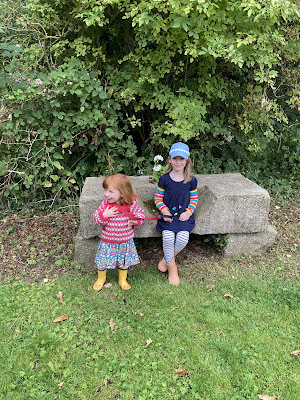

















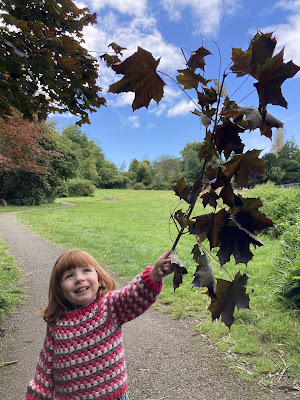






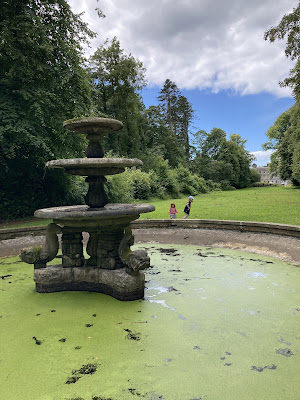



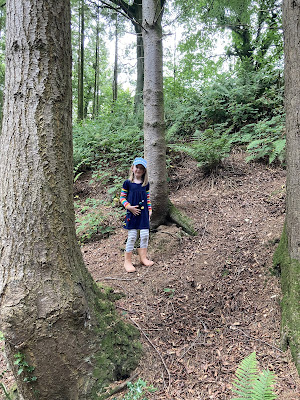














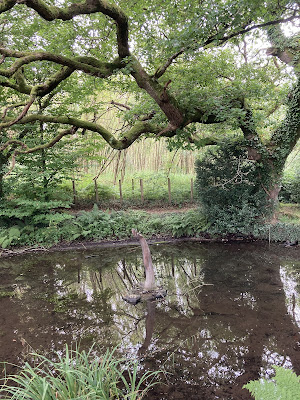





















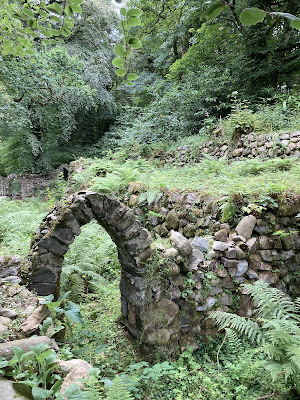
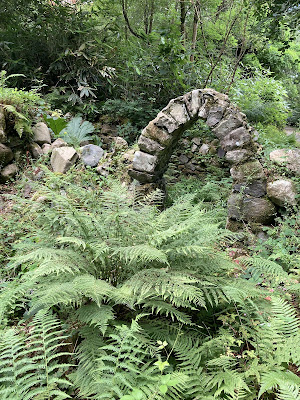





Comments
Post a Comment